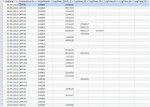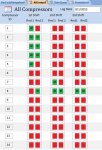Steve@trop
Registered User.
- Local time
- Today, 00:21
- Joined
- May 10, 2013
- Messages
- 148
I'm new to query design. I have a database where operators will enter readings from 14 different compressors, twice per shift, three shifts per day. In the Rounds table for each record the following fields are included:
Timestamp (includes date)
CompressorID (1-14)
Shift (1st, 2nd, 3rd)
Round (each set of readings is a round, each shift is supposed to do 2 per shift, the rounds are numbered Rnd 1 and Rnd 2)
Status (this is one of many readings they will record for each round/machine)
On the paper form it is easy for the operator to tell which machine they haven't recorded a round for yet because the space for it on the form is blank. In the Access form they are simply presented with a blank space to enter a new record. I'm trying to develop a strategy to make it easier for the operator to see at a glance which compressors they haven't entered readings for yet. Management also needs a weekly report of which rounds were done and which were missed.
I'm thinking of creating a datasheet from a query that will list the missing rounds for each compressor/round/shift based on the current date. I think I can put that datasheet onto the form the operator is using to record the readings or perhaps on a subform they can access with a button. I'm having trouble designing the query. So far I've created a query that lists all the rounds for a specific date, then another query that uses those results to list the compressors that are missing a record. I'm thinking that I'm making it too complicated than it needs to be. I'm hoping someone here will have a better strategy.
Thanks in advance,
Steve
Timestamp (includes date)
CompressorID (1-14)
Shift (1st, 2nd, 3rd)
Round (each set of readings is a round, each shift is supposed to do 2 per shift, the rounds are numbered Rnd 1 and Rnd 2)
Status (this is one of many readings they will record for each round/machine)
On the paper form it is easy for the operator to tell which machine they haven't recorded a round for yet because the space for it on the form is blank. In the Access form they are simply presented with a blank space to enter a new record. I'm trying to develop a strategy to make it easier for the operator to see at a glance which compressors they haven't entered readings for yet. Management also needs a weekly report of which rounds were done and which were missed.
I'm thinking of creating a datasheet from a query that will list the missing rounds for each compressor/round/shift based on the current date. I think I can put that datasheet onto the form the operator is using to record the readings or perhaps on a subform they can access with a button. I'm having trouble designing the query. So far I've created a query that lists all the rounds for a specific date, then another query that uses those results to list the compressors that are missing a record. I'm thinking that I'm making it too complicated than it needs to be. I'm hoping someone here will have a better strategy.
Thanks in advance,
Steve


